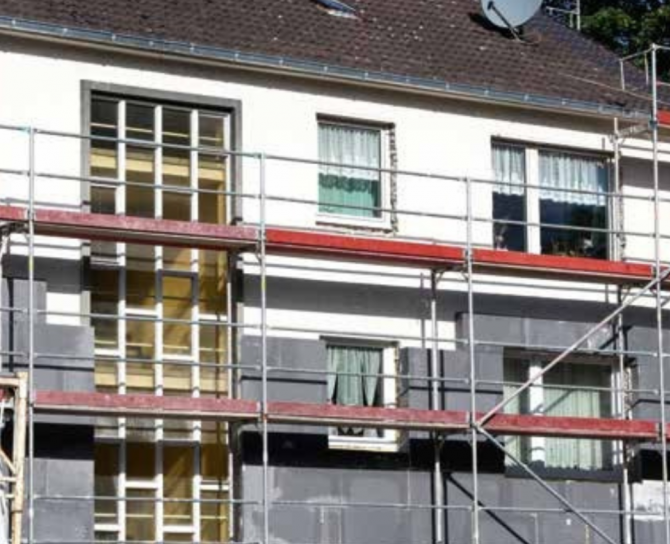
Adapted from the article “Aber bitte mit Sa(h)nierung!” by Lena Wechselberger, TGA 8/2024, Translated and adapted for the RENOINVEST project
Introduction
Renovation has long been considered the icing on the cake of Austria’s construction and building-related industries. Yet, despite a notable collapse in new construction, the country’s renovation rate remains stubbornly low — just 1.5% annually. With over 1.85 million housing units in need of refurbishment and ambitious EU climate targets looming, this figure is not just disappointing — it’s unsustainable.
Renovation Needs Outpace Action
Austria’s new construction slump is forecast to last at least through 2026, based on current data on planned housing developments. At the same time, the Monitoring System for Renovation Measures, commissioned by associations within the building products industry, identifies a clear imbalance: while new construction falters, the backlog of renovation demand continues to grow.
The sectors in greatest need of renovation include:
-
Private rental apartments
-
Municipal housing
-
Dwellings without a registered main residence
By contrast, non-profit rental housing is in relatively better condition. However, single-family homes deserve special attention due to their sheer number and varied energy performance. Calculations show that to reach full decarbonisation by 2040, Austria’s renovation rate would need to nearly double to 2.8%.
“At 66, life (for many an honorable, renovated house) is only just beginning!”
Barriers to a Renovation Surge
![Wolfgang Amann]
Wolfgang Amann is an Austrian housing researcher and managing partner of the Institute for Real Estate, Construction and Housing (IIBW).
There is no shortage of existing building stock — or labor capacity, given the declining demand in new construction. So why isn’t the sector booming?
Wolfgang Amann, Managing Partner of the Institute for Real Estate, Construction and Housing (IIBW), outlines several key reasons:
1. Homeowner Fatigue
“At the start of the war in Ukraine, people were highly emotional, fearing that gas supplies would be cut off,”
Amann explains.
That emotional urgency has since faded, leading to inertia among homeowners.
2. Complexity Overwhelms Individuals
“Coordinating contractors, checking whether the right materials have been installed, and ensuring the schedule is met — that’s really the job of property developers,”
says Amann.
3. Economic Disincentives
Generous subsidies are available, but they are not enough to overcome low energy prices.
“Gas prices are now almost back to pre-crisis levels. So if you calculate a renovation based on energy cost savings, the investments just don’t add up.”
Data Gaps Threaten EPBD Goals
The EU Energy Performance of Buildings Directive (EPBD) sets firm obligations for Member States to reduce the primary energy consumption of residential buildings by:
-
at least 16% by 2030, and
-
20–22% by 2035
Moreover, 55% of these savings must be achieved by upgrading the worst-performing buildings.
But therein lies the issue:
Austria lacks the data infrastructure to reliably identify which buildings need the most urgent action.
“It was a missed opportunity not to make this a federal responsibility,”
says Amann.
“The result: We have no reliable data on the thermal and energy performance of our buildings — which is actually a bad joke.”
Despite the existence of a central Energy Performance Certificate (EPC) database at Statistics Austria, in practice, the country’s federal provinces operate three separate systems, complicating national-level planning.
Lessons from 2009: A Model for Mobilisation
While current conditions are challenging, Austria has succeeded before. After the 2008 global financial crisis, the government introduced a Renovation Bonus to stimulate the economy. The result? Record-high renovation figures in 2009.
What made it work?
-
Federal and provincial governments competed to offer better subsidies
-
Some regions removed income thresholds to widen access
-
Most critically: building societies (Bausparkassen) acted as free submission points
“Bausparkassen are extremely important partners, especially for single-family homes, because they financed the construction of millions of them. That means they already had direct contacts with households — and those households could then be steered toward renovation,”
explains Amann.
Differentiated Funding Landscape and the EWP
Austria’s current flagship programme, the Renewable Heat Package (EWP), provides significant support — covering up to 75% of the cost of a new heating system when combined with state-level incentives. Its impact is visible:
Heating system replacements jumped from around 15,000 to nearly 80,000 in 2023.
But progress on thermal building upgrades and comprehensive renovations remains slow.
“When it comes to individual thermal building component measures, we’re stagnating at a low level. And even for comprehensive renovations, there’s not much real progress.”
A Strategic Way Forward
The latest Monitoring Report on Renovation Measures urges Austria to implement coordinated policy bundles, including:
-
Financial incentives
-
Improved legal and regulatory frameworks
-
Awareness-raising campaigns
These measures should be tailored to specific building types and owner groups, ensuring greater impact.
“Almost like giving each dollop of whipped cream its own cherry on top,”
quips Amann.
Conclusion
Austria has the tools, experience, and need — but not yet the momentum. The country’s renovation rate remains too low to meet EU climate targets, despite available funding and policy frameworks. As Wolfgang Amann emphasizes, the problem is not a lack of intent but of coordination, data, and execution.
To shift from stagnation to acceleration, Austria must:
-
Centralize and harmonize data collection
-
Engage key actors like Bausparkassen
-
Simplify access to support for private homeowners
Without a systemic push, the renovation wave will remain a ripple. But with the right actions, Austria could once again become a model for large-scale energy renovation — just as it did in 2009.
